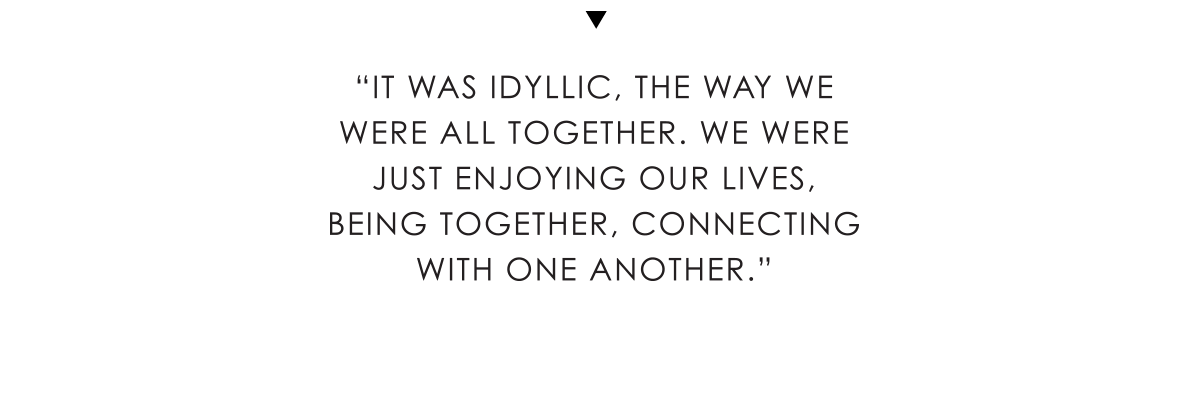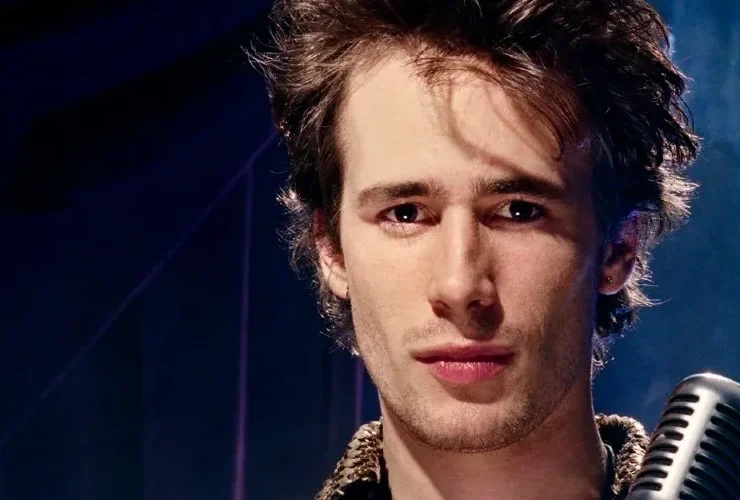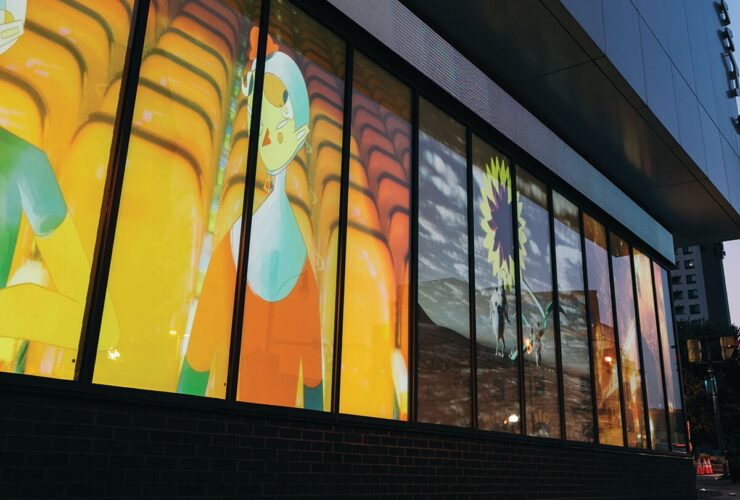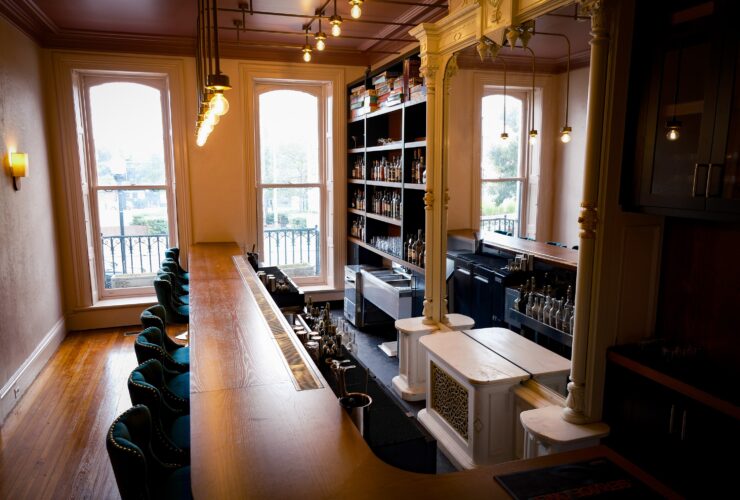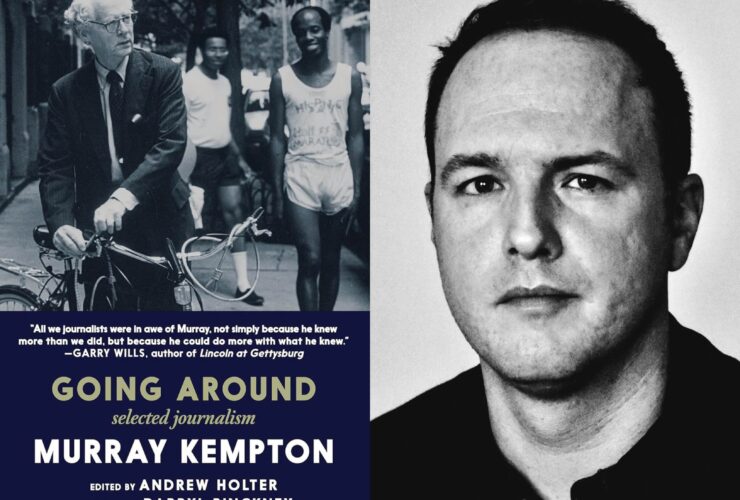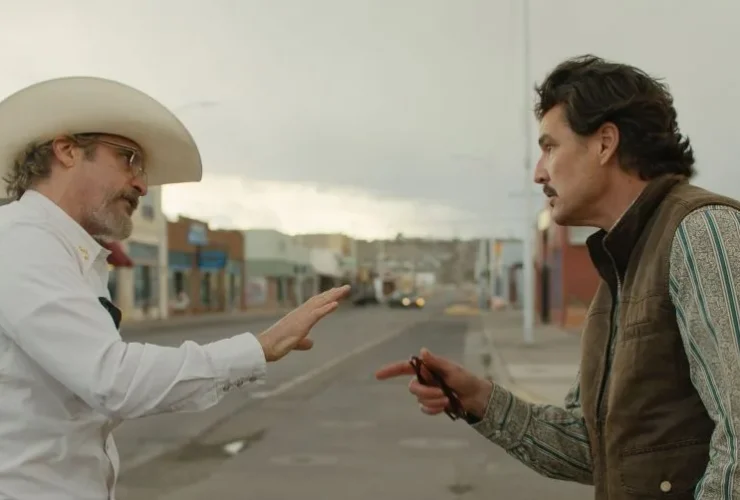
Arts & Culture
The Big Dreams of Derrick Adams
The Baltimore artist conjures a canvas out of his hometown.
By Lydia Woolever
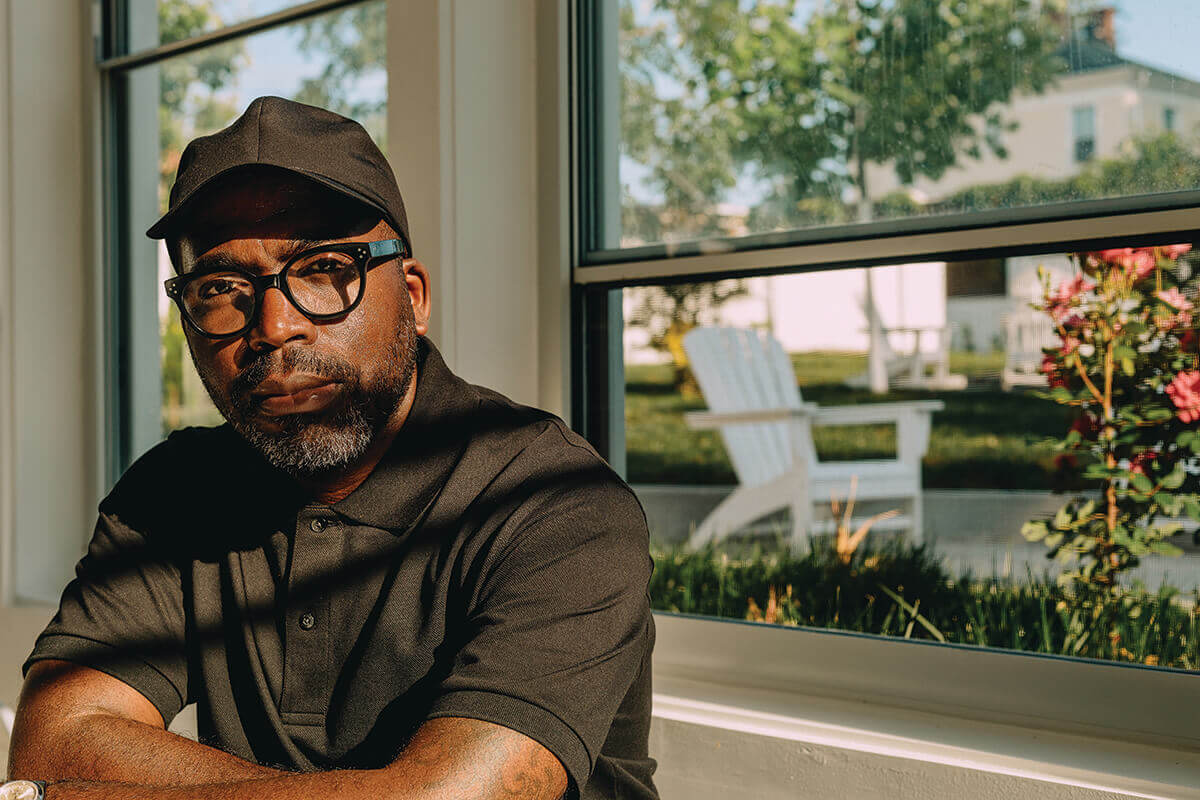

THE TUCKED-AWAY 500 BLOCK of Chestnut Hill Avenue in Upper Waverly, there sits a radiant dream.
Up a flight of stairs, through a latticed fence, there is a sprawling three-story house that’s as airy and ivory as the cumulus clouds that drift through the sky on this May afternoon. Everything across this one-acre property is the same hue: the walls, the windows, the gauzy shades that hang from the wrap-around porch, and the rocking chairs that encourage guests to stay awhile amidst the freshly planted trees and recently hung string lights of The Last Resort Artist Retreat.
“Your life is already artful—waiting, just waiting, for you to make it art,” reads a quote from author Toni Morrison on a letterboard that hangs near the patio, which is surrounded by a lush green lawn and speckled with umbrellas, picnic tables, and one especially alluring hammock. A pink rosebush pops against the milky color scheme, with no city sounds out here in North Baltimore—just birdsong and the breeze.
Before long, a screen door creaks open, breaking the spell, and out ambles Derrick Adams, dressed in a crisp, all-black outfit, from his baseball hat and thick-rimmed glasses to Nike sneakers, the lone exception being a gold pinkie ring.
“Right now, it’s kind of quiet,” says Adams, looking around the grounds, which the Baltimore-born, Brooklyn-based artist first purchased as a crash pad for his frequent trips to his hometown, before pivoting it for the public.
But The Last Resort has already been bustling, with this urban oasis for Black creatives in the midst of a soft opening featuring intimate dinner parties, photography exhibitions, and a revolving door of notable artists, from local talent like photographer Devin Allen, writer D. Watkins, and sculptor Murjoni Merriweather to national celebrities like painter Amy Sherald, actress Lupita Nyong’o, and musician Solange Knowles.
And later this year, upon its official launch, it will welcome the first cohort of its residency program, in which four Black artists of varying disciplines—including one always from the Baltimore area—will be chosen for a month-long stay with curated programming and studio space.
The idea is not about making art, but rather embracing the rest, rejuvenation, and communal exchange—casual not transactional—that can fuel creativity. Because, for Black Americans, leisure is a radical act, concludes Adams, if not the lifeblood of resistance—an ethos at the core of his entire practice.
“We live in a society that says your value is based on your productivity,” he says, leaning back in one of the porch rockers with a cool grace—his vision unfurling in stream of consciousness, his hands moving with each new thought like a conductor. “But the position of the artist is also the position of the philosopher. And my philosophy is that, if you’re a creative person, you can’t turn off creativity. . . . It’s not about how much an artist makes, but what they bring to the table.”
And lately, in Baltimore, that’s been a lot from Adams.
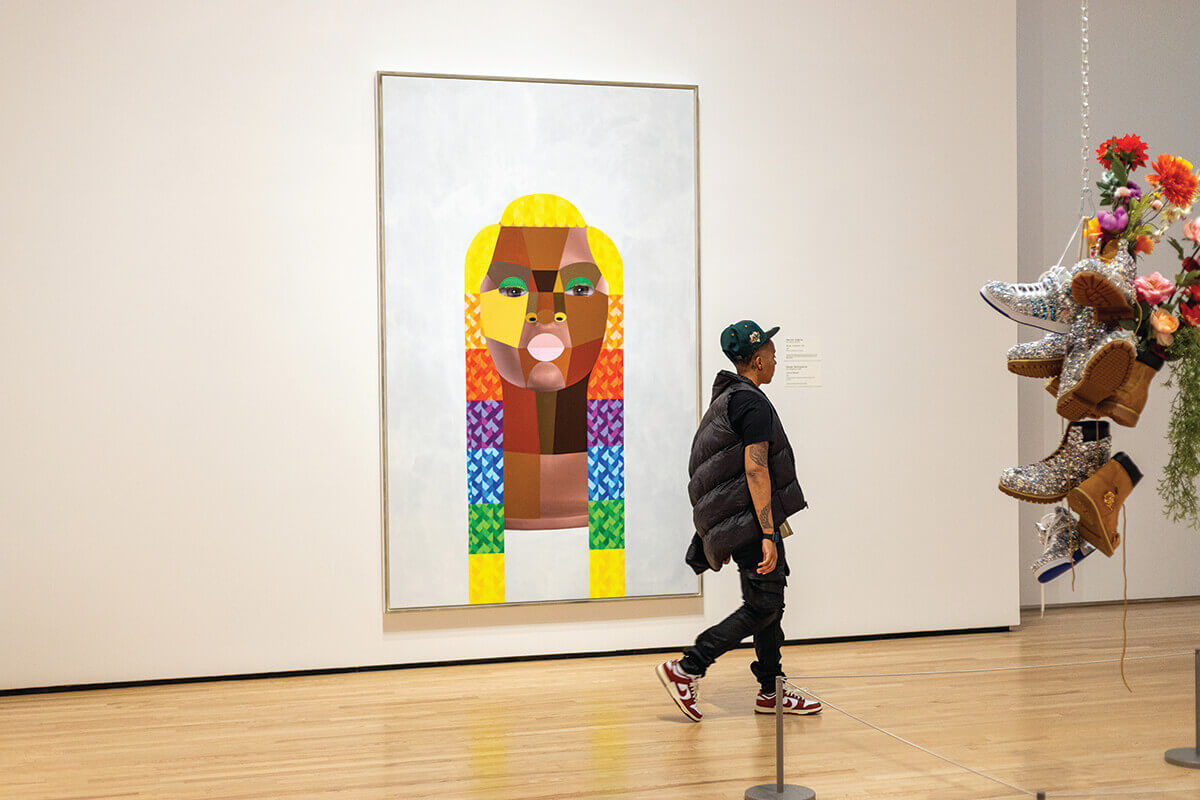
Opening spread: Derrick Adams at The Last Resort Artist Retreat. Above: "Style Variation 34” (2020) hangs at the Baltimore Museum of Art.

n the front living room of The Last Resort, a large woodblock screen print hangs on the west-facing wall, featuring a Black boy lounging in a green polka-dotted bathing suit aboard a swan-shaped swimming pool floatie, just one of the many works that have drawn attention to the oeuvre of Derrick Adams lately.
Using bright Cubist blocks of color and bold portraiture, the 53-year-old artist is perhaps best known as a painter, with his oils and acrylics joining a growing tradition of Black artists who have made their central theme that of ordinary life. Across his distinctly vibrant canvases, he composes delightful depictions of birthday parties, bicycle rides, shoe-shopping, and church Sundays, focusing not on the struggle of the Black American experience, but the joy of it.
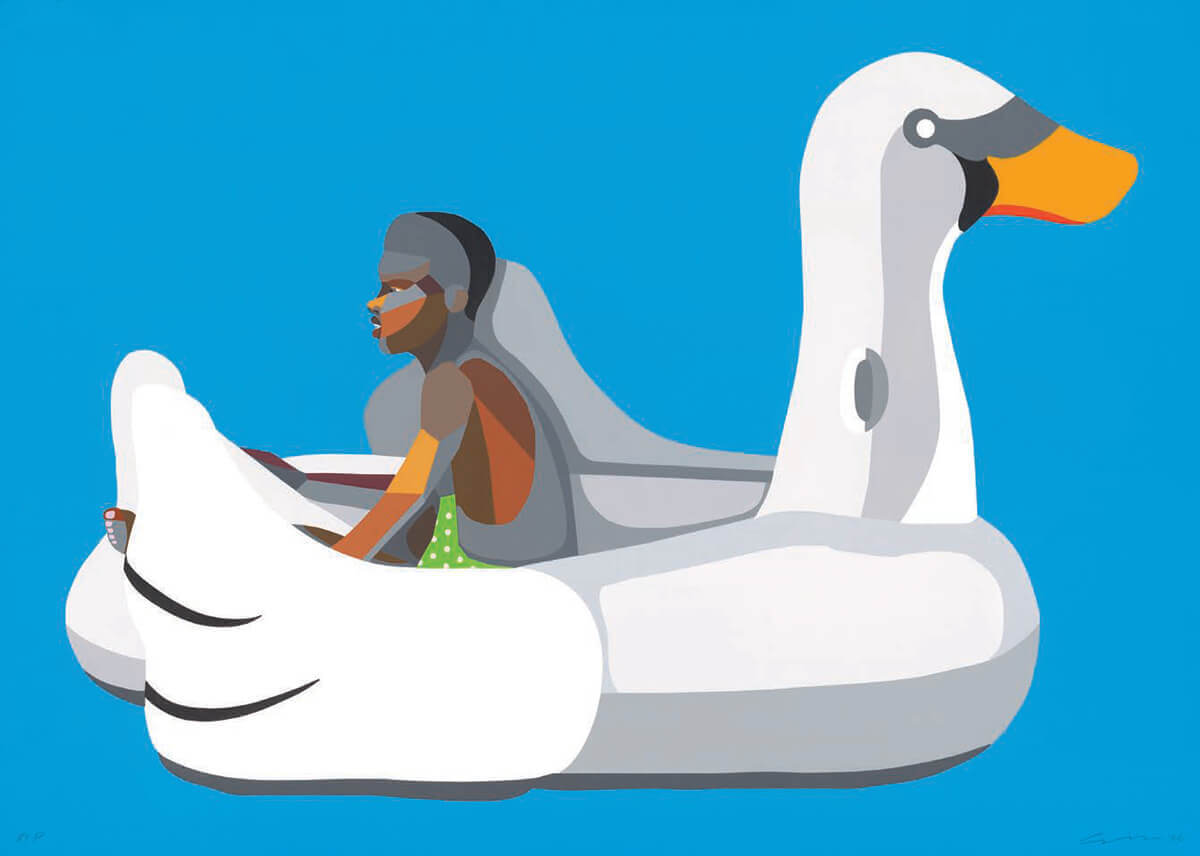
“Boy On Swan Float” (2020). —COURTESY OF DERRICK ADAMS STUDIO
But his art doesn’t stop there. Adams is interested in pushing the limits of his creativity, reveling in the unfamiliarity of a new medium, and the ways in which those works can convey “the nuances and surprises and mistakes and emotion and vulnerability” of being human. And so his multidisciplinary practice also includes everything from collage, photography, and video to performance, fashion, and public installations, the latter of which have graced New York’s Penn Station, Chicago’s Navy Pier, and the National Mall in Washington, D.C.
The result is often playful and unexpected. Like this summer, when he created limited-edition sculptures shaped like life-sized summer popsicles (which were later Instagrammed by Martha Stewart). And it’s this endless imagination—and exhaustive curiosity—that has set the prolific polymath on the path toward becoming a household name.
“Derrick is one of the hardest-working artists in the contemporary art field, without question,” says Jessica Bell Brown, contemporary art curator at the Baltimore Museum of Art. “There is a rigor to his practice, and in this particular moment, his work is even more prescient. It’s a reminder that happiness and ease and resilience are powerful modes of being for Black people in this country.”
And the response has been undeniable. Suddenly, it seems like Adams is everywhere. His work is being exhibited in art galleries around the world, from Miami to Paris to Hong Kong, and kept in the permanent collections of the Metropolitan Museum of Art, the Whitney Museum of American Art, and the Virginia Museum of Fine Arts, to name a few. For the art-world initiated, it was major news when, earlier this year, the illustrious Gagosian gallery in Los Angeles announced that Adams would be added to its roster of represented artists. For novice aesthetes, it’s of equal note that his canvases have made cameos in Beyoncé videos and Sex and the City episodes, as well as on the pages of The New York Times and Vogue.
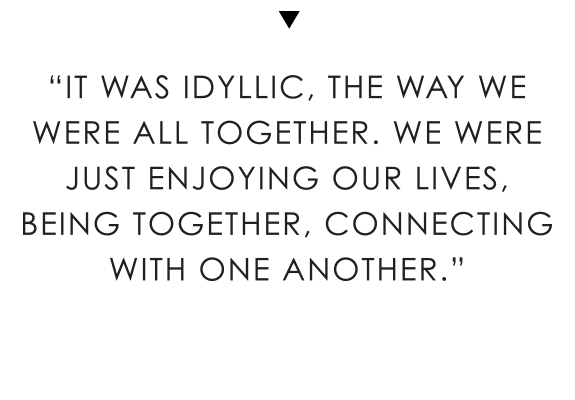
“He’s one of the most important artists of our time,” says Thomas James, executive director at The Last Resort, who curated shows at venues such as Creative Alliance in Highlandtown and the Phillips Collection in D.C. before arriving at his position. “His works are so coveted, yet there’s a level of accessibility to them...offering an entry point for intellectualism on any level.”
In a way, that’s because Adams is a Baltimore kid at heart, and even amidst all of his success, he hasn’t forgotten where he comes from. In fact, most of his energy is being focused back on his hometown these days.
Just down the block from The Last Resort, the forthcoming Black Baltimore Digital Database, envisioned as an avant-garde archive for local African-American history, is in the planning stages. Meanwhile, in the Midway neighborhood, he’s collaborating on the future Sock Factory, a communal creative space that will house artist workspaces and area nonprofits like his own umbrella group, Charm City Cultural Cultivation. And, too, there’s the Mount Royal Tavern in Mid-Town Belvedere. In March, Adams purchased the iconic dive bar with a coterie of other artists, including The Compound’s Nicholas Wisniewski and electronic composer Dan Deacon. (Don’t worry; they plan to keep it as-is.) Altogether, he’s hoping to elevate the creative ecosystem here, and in a way that lifts up the city while he’s at it.
“Derrick is an undeniable force,” says Brown. “He is self-possessed, and community-minded, and working toward a kind of collectivity. That power of his vision—to not only rise himself, but bring others with him—can’t be denied. It’s a thrill to witness it.”
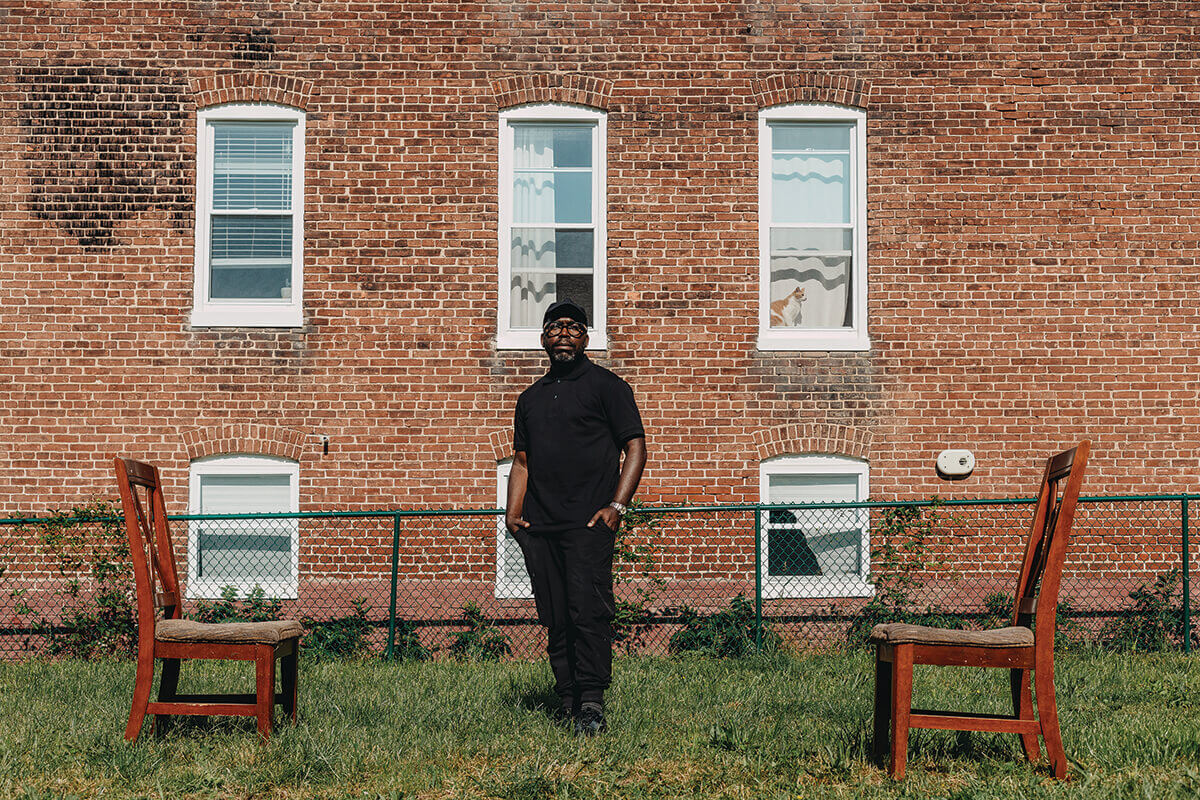
Adams today in front of the future site of the Black Baltimore Digital Database in Upper Waverly.

orn in 1970, Adams grew up across the city, but Park Heights was always home base. Here, his maternal grandparents lived in a house not unlike The Last Resort, with a wide porch, an abundant vegetable garden, and tree swings installed by his grandfather. He’s described the Wylie Avenue homestead as a sort of “Black American utopia,” and it was the axis of his close-knit family’s universe, always drawing a crowd and full of food, books, and music—a dominant force in his young life. “My grandmother was the creative spirit of our family, and if anyone expressed that energy, she would support it,” says Adams, who joined her in their church choir.
“It was idyllic, the way we were all together, and I think that fostered what a world could look like for Derrick,” says Victoria Adams-Kennedy, his older sister, who recalls the siblings connecting over Baltimore club records and musicians of the era like Sade. “We were just enjoying our lives, being together, connecting with one another. It was one of those families where we’d be sitting around the house and spontaneously someone would start singing a song, or reading a poem, and then everyone else would join in.”
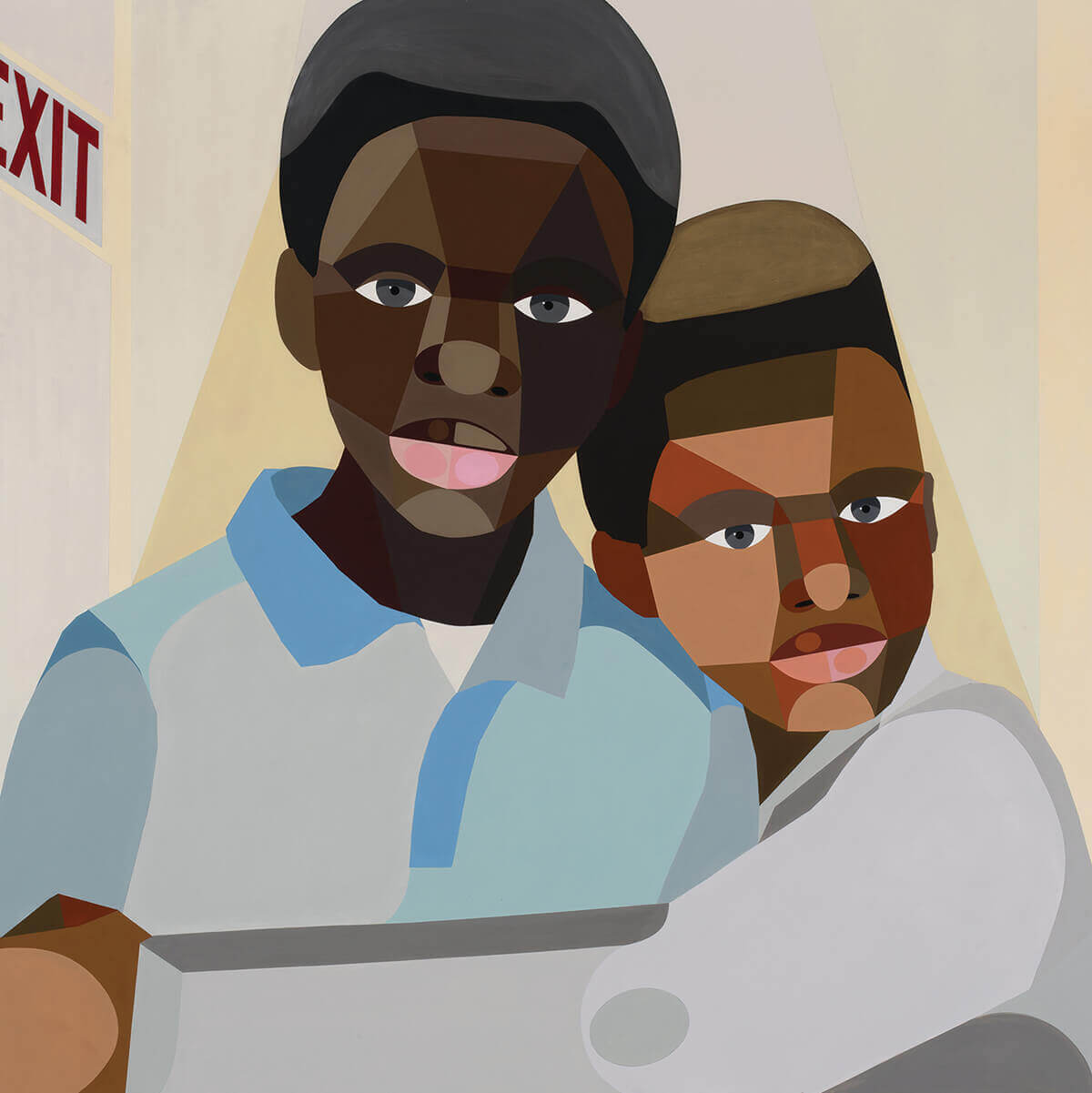
“Hold On Tight” (2022). —COURTESY OF DERRICK ADAMS STUDIO
It’s no surprise then that the Adamses are something of an artistic dynasty. Derrick’s parents worked for the state, but after getting a divorce, his mother remarried drummer Guy Davidson, who played with George Clinton’s Parliament- Funkadelic. Her first cousins were the famous Simmons brothers—Russell of Def Jam Recordings, Joseph of Run-D.M.C., and Danny, an abstract-expressionist painter—who spent their summers in Baltimore. And by the time her brother, Clifford, a graphic designer, started offering Derrick his first official drawing lessons, he had already come to his calling. “He started very young, and I’m talking five years old, or even earlier,” says Adams-Kennedy, who is also an author, playwright, and founder of the Zora’s Den writer’s group, while her son, Lawrence Burney, is the local art critic behind True Laurels. “My brother could just play by himself for hours, creating entire worlds with his imagination.”
She recalls a kind, considerate, introspective child, with pencils and crayons never far from reach. Before long, his teachers at Edgecombe Circle Elementary School took notice and enlisted him to create posters for the hallways, holidays, and other happenings. At age nine, he won Mayor William Donald Schaefer’s city-wide student art contest. His work was hung in City Hall. “Art was all mine, and it was all me,” says Adams. “It was a way to express myself, and also process my thoughts and the world around me.”
After high school, Adams attended Baltimore City Community College, where research for a book report took him on a trip to the Enoch Pratt Free Library and introduced him to the midcentury modernist painter Jacob Lawrence. At the time, he had started to host small salon-style art gatherings with a few friends on North Avenue, but paging through those colorful, Cubist paintings—devoted to the Great Migration, Harriet Tubman, and life in Harlem—struck a chord with the young artist. Soon after, he found himself applying to Lawrence’s alma mater, the Pratt Institute in Brooklyn. “Jacob Lawrence was a pioneer,” says Adams. “He was able to have conversations surrounding the Black experience without compromising the truth. And despite the challenges of his time, he never deferred from his vision.”
Already a practicing artist, Adams majored in arts education, seeing that degree as a means to bridge some of the gaps of his own studies, which rarely focused on Black artists. After graduation, he worked as the curator at the Simmons’ Rush Arts Gallery, helping to establish then-fledgling artists such as BMA darling Mickalene Thomas and Obama portraitist Kehinde Wiley. On the side, he taught art at elementary schools and eventually landed a position as a professor at Brooklyn College, where he remains tenured today. He never stopped making his own work, though, and within a few years, he focused his energy toward it, earning a graduate degree in visual arts at Columbia University.
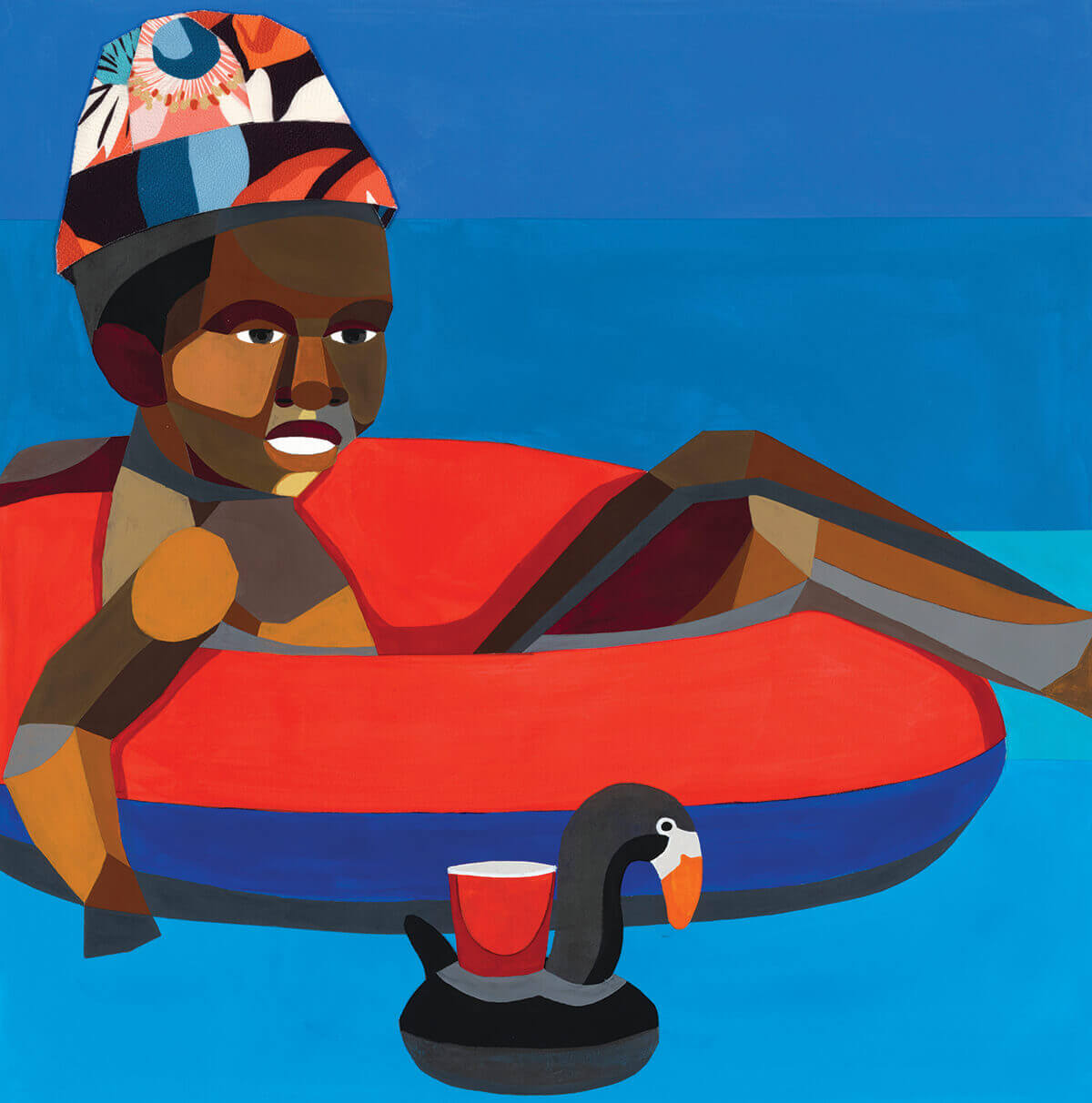
“Floater 85” (2019). —COURTESY OF DERRICK ADAMS STUDIO
In the early aughts, Adams was featured in exhibitions in prestigious art institutions like the Brooklyn Museum and Museum of Modern Art’s PS1, but his big break came in 2014, during a solo show at New York’s Tilton Gallery. Each of his 4-by-6-foot collages depicted a television screen of early commercials, sitcoms, and game shows that seemed to scrutinize Black stereotypes and American culture with a hat tip toward Pop Art and a touch of wry humor, garnering a glowing review from the Times, which called them “big, booming and seductive, but sharp-edged.”
Still, it would be another year or two before Adams found his main muse, via a 1967 Ebony magazine story on Dr. Martin Luther King Jr. In full Kodachrome glory, the civil rights leader is photographed on a family vacation in Jamaica—lounging in a pool, sitting on a patio, wandering beneath the palm trees. Adams was struck by the all-American iconography of the images—and how rare it was to see a Black family represented in such a way: in the midst of recreation, relaxation, simply at ease.
His subsequent series would stake this territory as his signature: the pool floaties, the party hats, the road trip figures inspired by The Negro Motorist Green Book, which also sparked a traveling exhibition in cities from the Jim Crow-era guide.
“I am depicting Black figures doing more than just pushing back—against obstacles or opposition or oppression—all of which are important topics,” says Adams. “But I believe there is a space for representing them without those constraints. . . . I am depicting the Black figure in the way that it sees itself.”
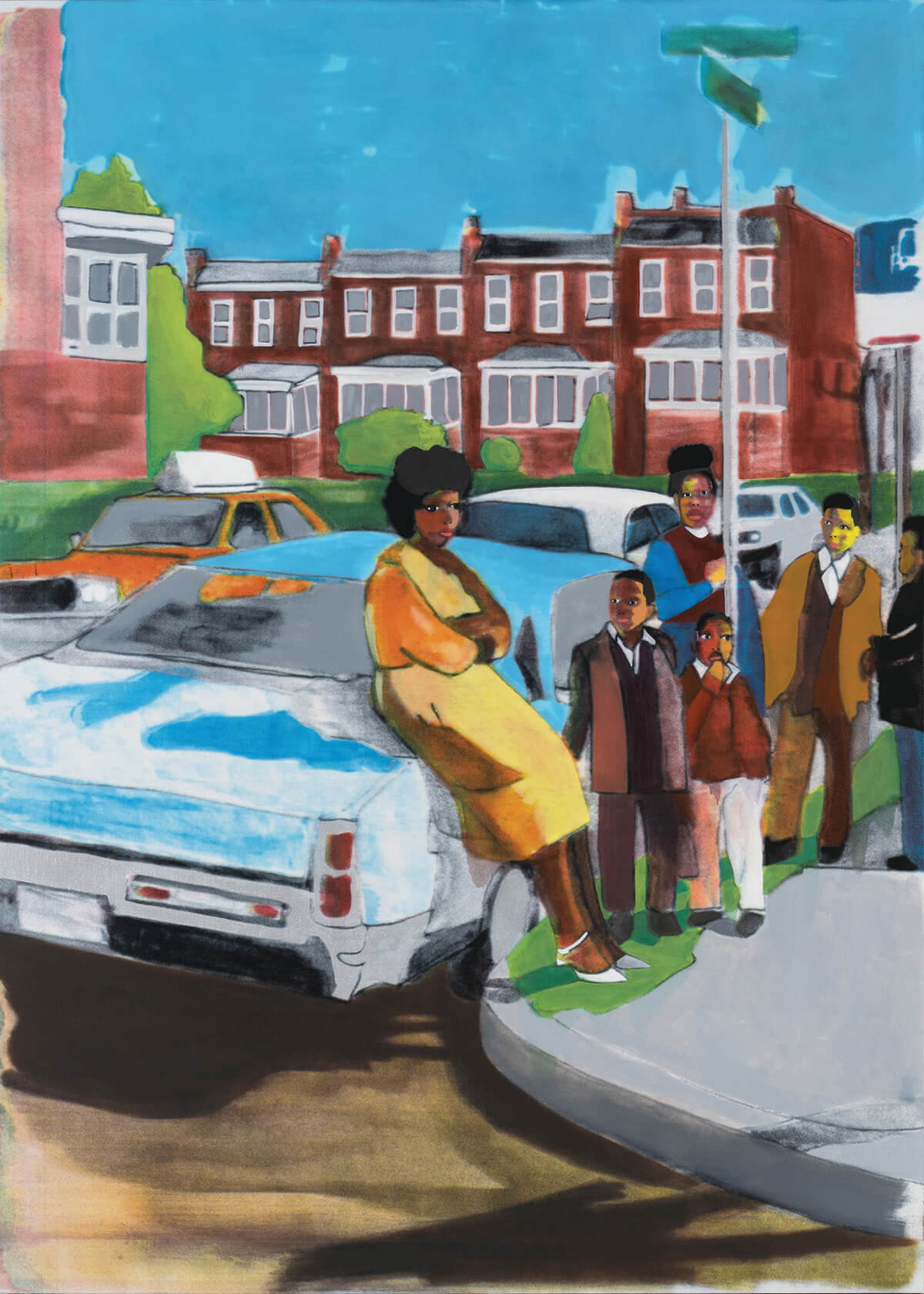
“Family
Portrait #4” (2019),
from Adams’
“Where I’m From”
series, featured at
Baltimore City Hall. —COURTESY OF DERRICK ADAMS STUDIO

ast the gilded European landscapes, around the ancient Roman sculptures, through the esteemed Cone Collection, and into the contemporary wing of the BMA, there hangs a painting created by Adams in 2020. On the northwest wall, his “Style Variation 34” depicts the bust of a fashion-forward mannequin head. At eight feet tall, set against a marble-esque backdrop, her skin gleams, her eyes focus, and her rainbow-colored, cornrow-style braids dangle in perfect symmetry, like a warrior’s headdress. Regal and resolute, she makes the bold adornment of Black women a natural sight in the hallowed halls of this 109-year-old art institution. “That bravado, that sense of self, is what makes this painting so amazing to me,” says Brown, adding that Adams “amplifies Black visuality.”
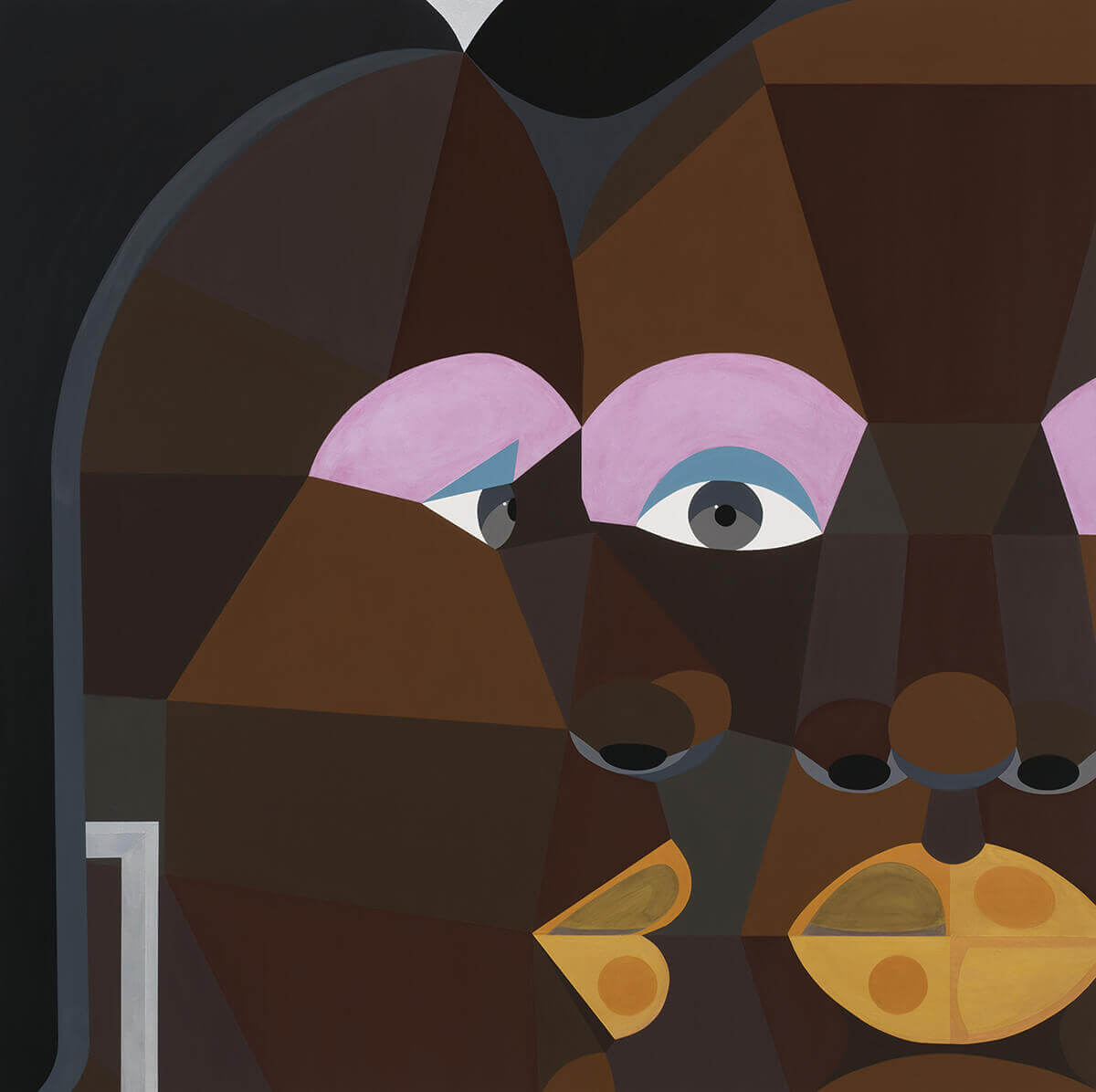
“Fixing My Face”
(2021). —COURTESY OF DERRICK ADAMS STUDIO
Purchased in 2021, this was his first work to join the museum’s permanent collection, and it was most recently on display during this summer’s groundbreaking exhibition, “The Culture: Hip Hop and Contemporary Art in the 21st Century.” From April through June, it could also be seen promoting the show on banners and bus stations around Baltimore, often causing his sister to send her brother a cell-phone picture. “I’d tell him, ‘You’re everywhere,’ and we’d just laugh,” says Adams-Kennedy. “He’s been at this a long time. I’m filled with pride that he’s starting to see the fruits of his labor. I just wish our parents and grandparents could see it.”
For Adams, who has been an established artist outside of Baltimore for well over a decade, this kind of hometown recognition has been a long time coming.
It started in earnest in 2019, when in a full-circle moment, the City Hall art gallery hosted his first and only solo exhibition in Baltimore, titled “Where I’m From.” Through the rotunda, 10 family photographs had been transformed into large-scale oil-on-linen odes to his upbringing—cousins standing on the West Baltimore sidewalk, an aunt with a boom box in Druid Hill Park—the same kind of quotidian beauty that has inspired much of his work over the years.
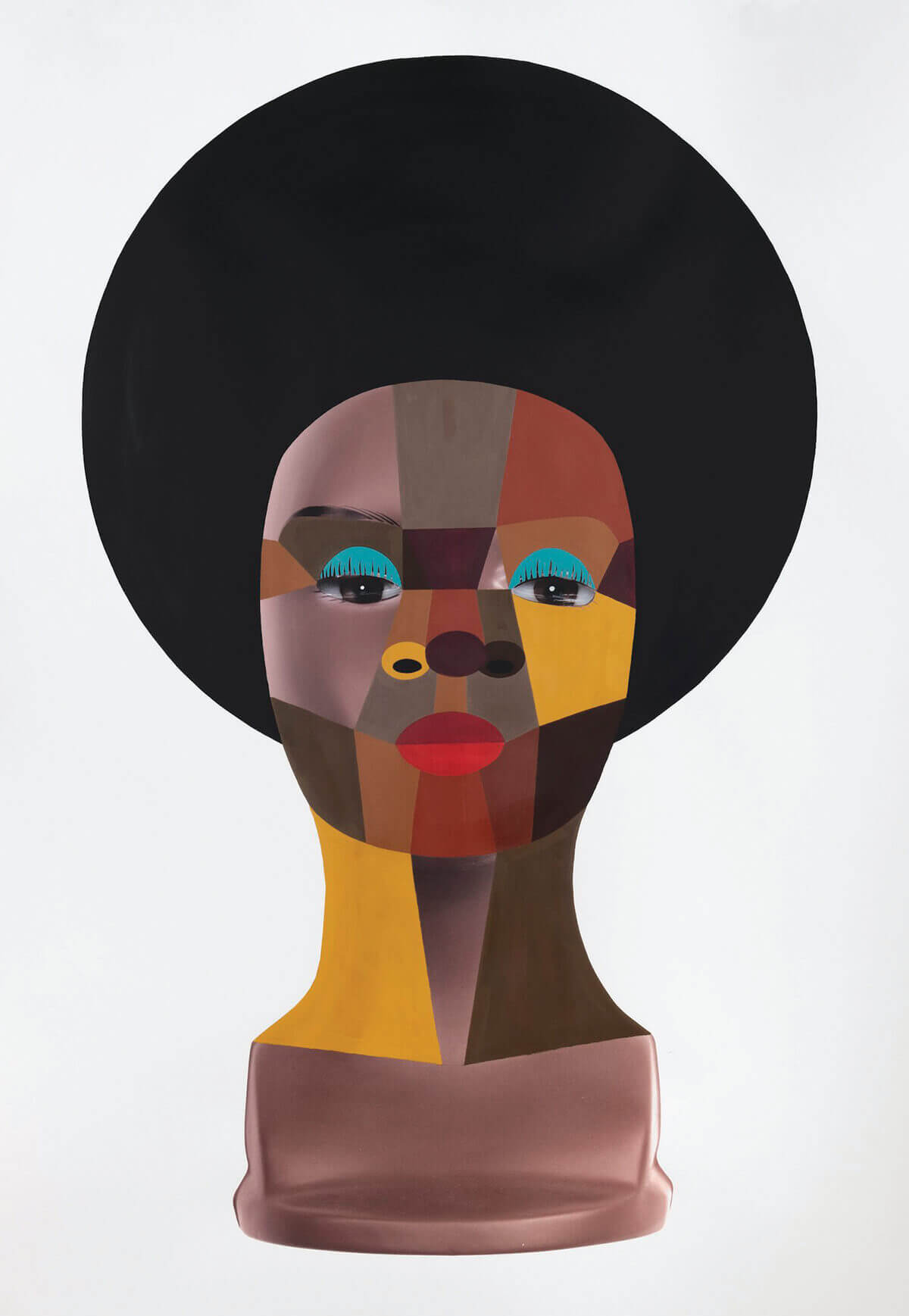
Style Variation #3” (2018) —COURTESY OF DERRICK ADAMS STUDIO
Here and there, Adams has been included in events around town, like a talk at the Creative Alliance and a visiting Smithsonian exhibit at the Reginald F. Lewis Museum. He’s also helped curate shows at the Eubie Blake Cultural Center, where he sits on the advisory board. But his recent attention from the BMA has been the biggest to date.
It comes in the midst of a moment of reckoning for art institutions across the country. Since 2020, museums and galleries have faced increasing scrutiny to diversify their spaces, with initiatives ranging from more inclusive staffs and equitable salaries to the acquisition and exhibition of underrepresented artists of color. During this time, the BMA brought in works by local Black creatives like Jerrell Gibbs, Akea Brionne, LaToya Hobbs, and Theresa Chromati, part of a commitment to create a space more welcoming to and reflective of its entire community, which has become even more urgent under the leadership of former-curator, now-director Asma Naeem. She oversaw the long-overdue retrospective of legendary Baltimore-based printmaker Valerie Maynard and the “Guarding the Art” exhibition curated by the museum’s security staff. She also used proceeds from this year’s BMA gala to benefit Adams’ Last Resort retreat.
“Folks will say this is a majority-Black city and point to the laundry list of Black talent from here, but then all the great institutions have not necessarily been for them or kept them in mind, and that’s the disconnect,” says Tonya Miller, senior advisor of arts and cultural affairs for Mayor Brandon Scott, who knew Adams as a child. “How do we expect these artists to push through without support?”
Only time will tell how it all trickles down. Though Adams isn’t waiting around to find out.
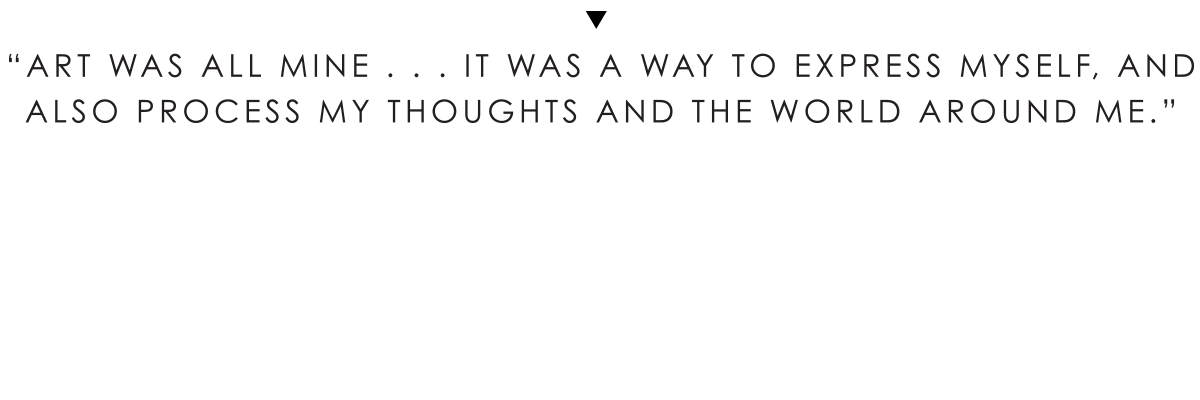
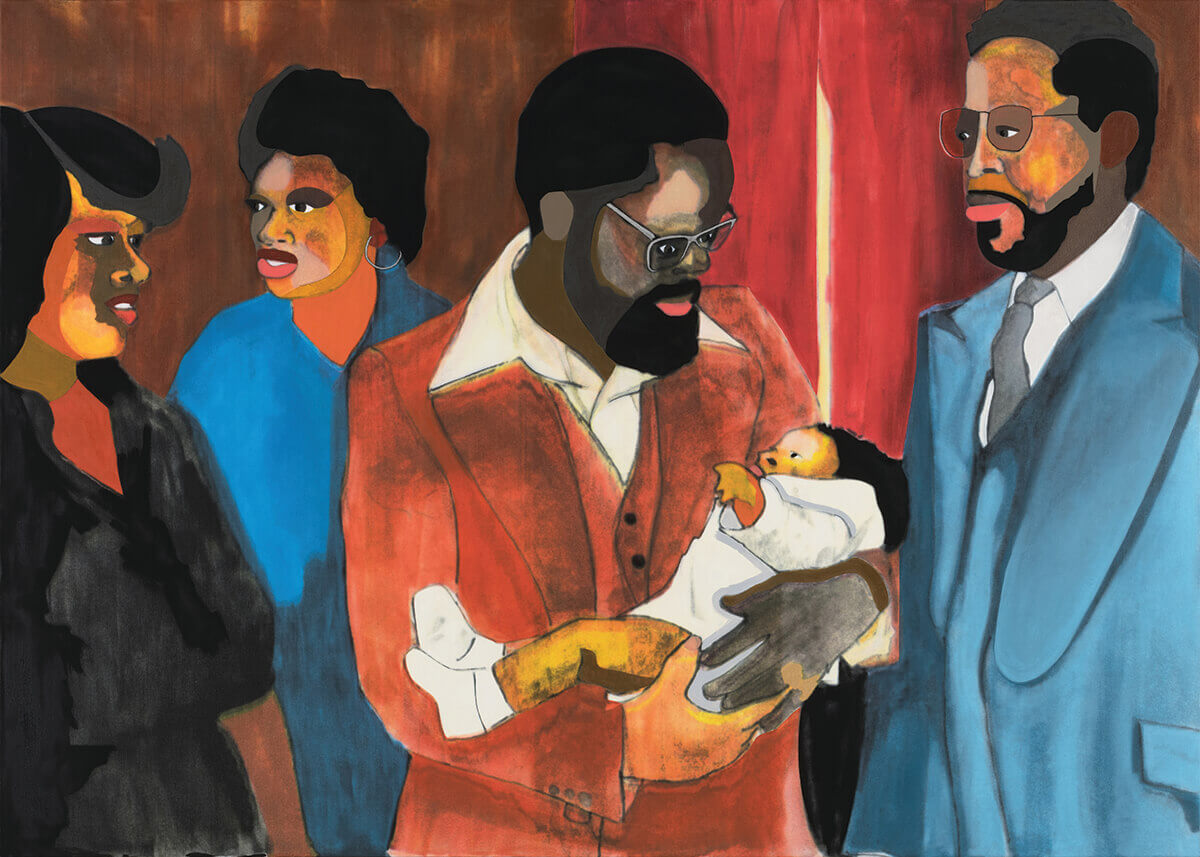
“Family Portrait #6” (2019). —COURTESY OF DERRICK ADAMS STUDIO

t’s a common adage in Baltimore: An artist has to leave the city in order to make it. And Adams believes that was true for him, too.
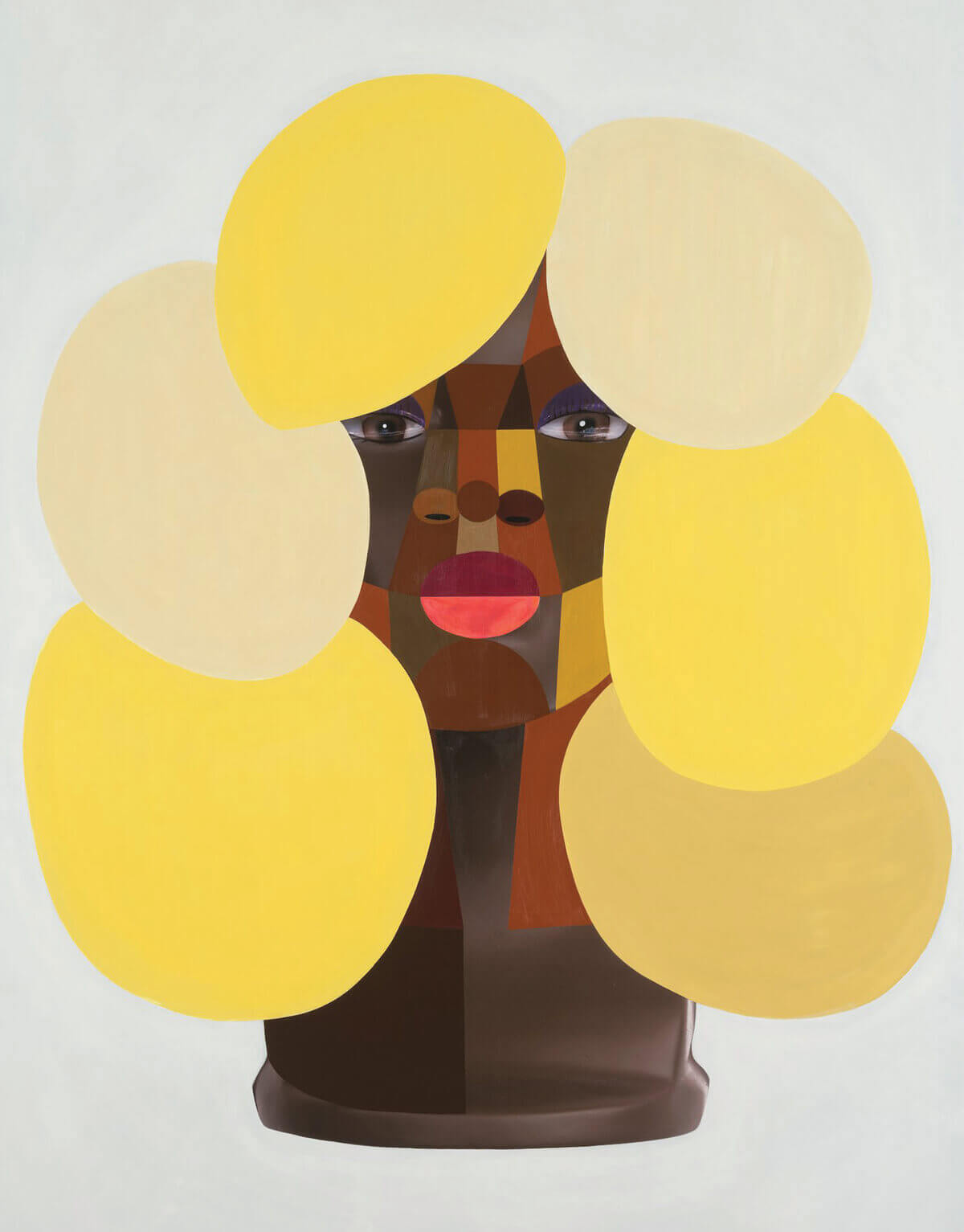
A detail from “Style
Variation 17” (2019). —COURTESY OF DERRICK ADAMS STUDIO
“In New York, I saw what artists can do when they are valued,” he says. “And when those folks leave, opportunity and commerce goes with them. . . . Baltimore has underestimated the power of creativity to transform a city.”
He’s referring to the fact that financial support is highly competitive here, with a handful of public and private grants allocated for just a few dozen winners each year. The Baltimore Office of Promotion & The Arts gives out some $300,000, but it’s spread across both artists and organizations, and overall, less than one percent of the city’s budget goes toward the arts.
Of course, in a town riddled with deeply rooted racial inequities and continuously reeling from some 300 murders a year, supporting the arts can seem trivial in comparison to other needs, which is a fact not lost on Adams. But he sees that investment as the very antidote, with studies showing that creative programs are directly correlated with crime reduction, as well as increased academic, social, and emotional achievement for young people.
If the state, the city, its institutions, and successful expats like himself invested more support for local artists, muses Adams, then not only could Baltimore’s artistic ecosystem truly thrive, but the greater art world might take notice, and invest in the city, too. And The Last Resort could lead the way.
“Some people think this is a passion project, but it’s really more so a sense of obligation,” he says. “I’m hoping that what I’m doing will entice others to follow suit.”
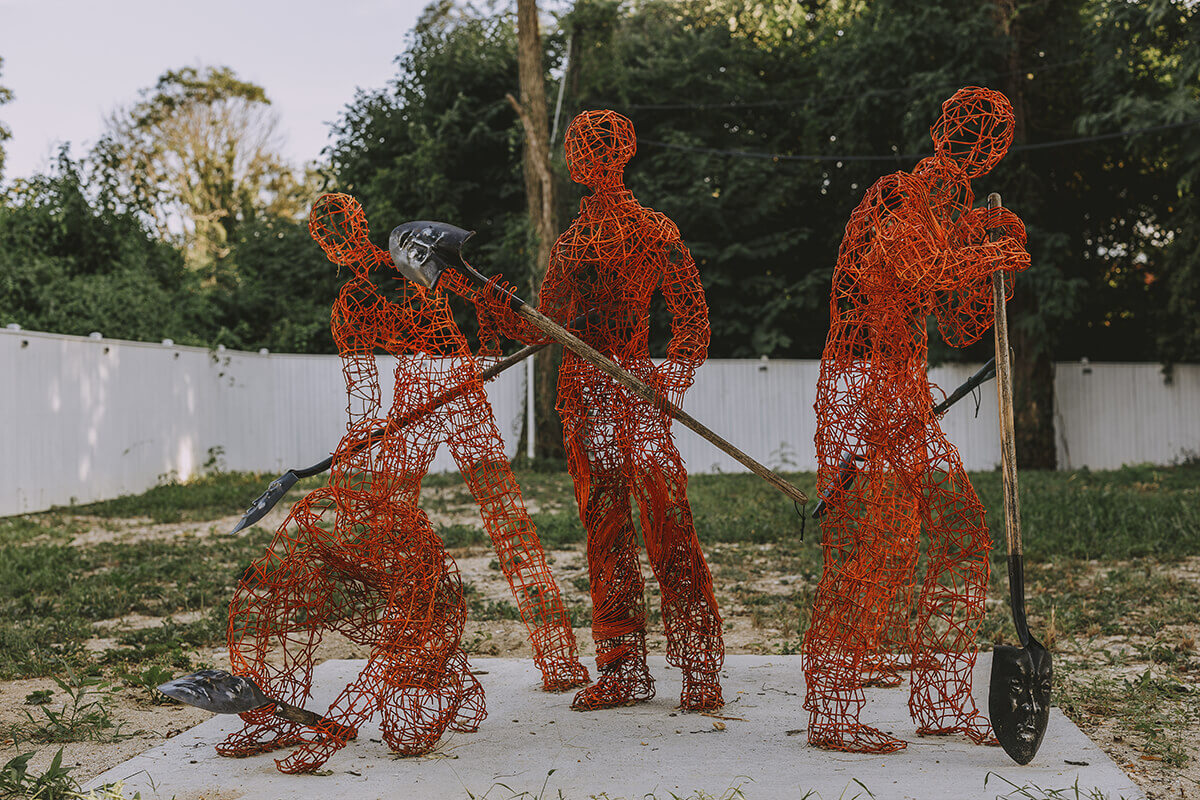
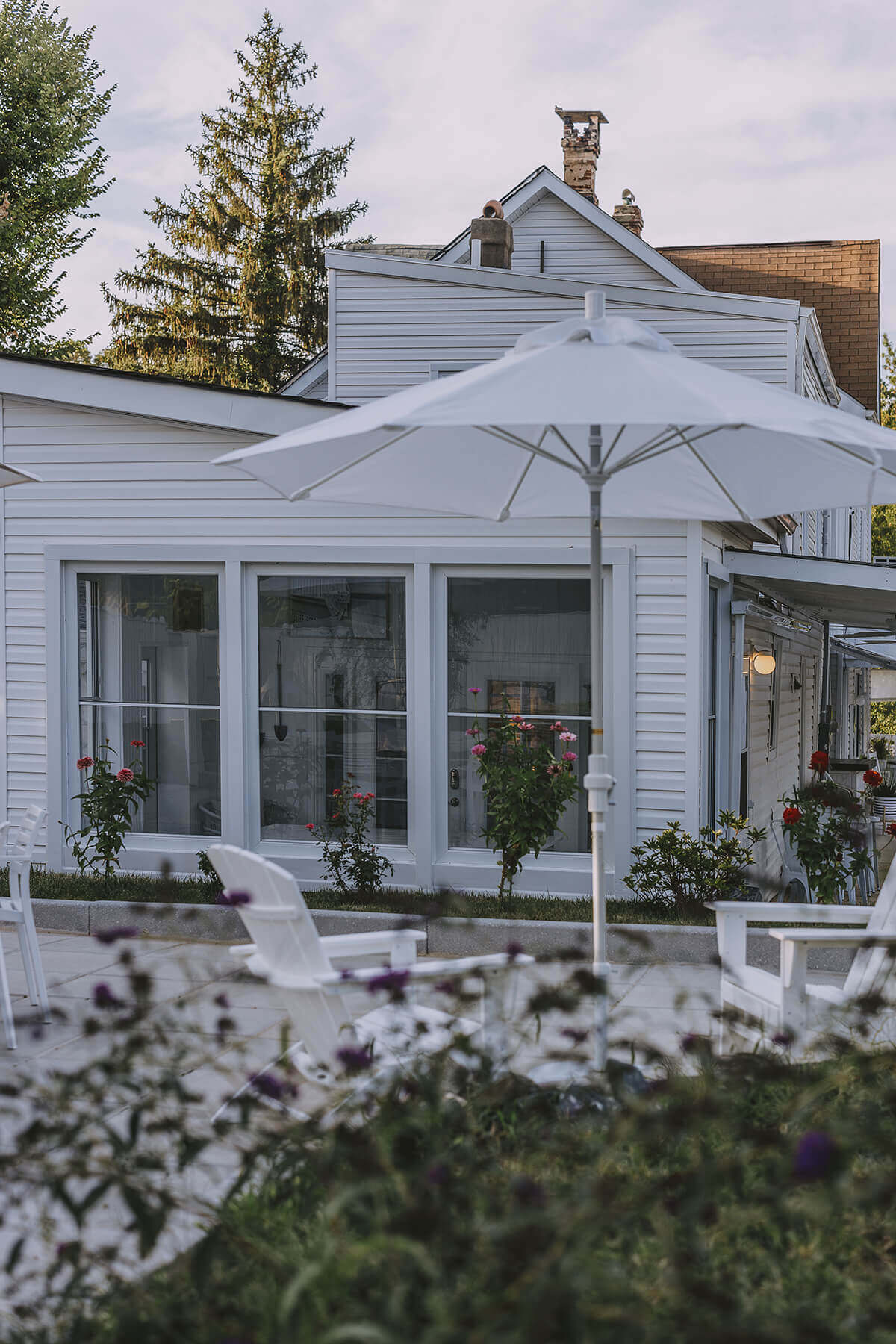
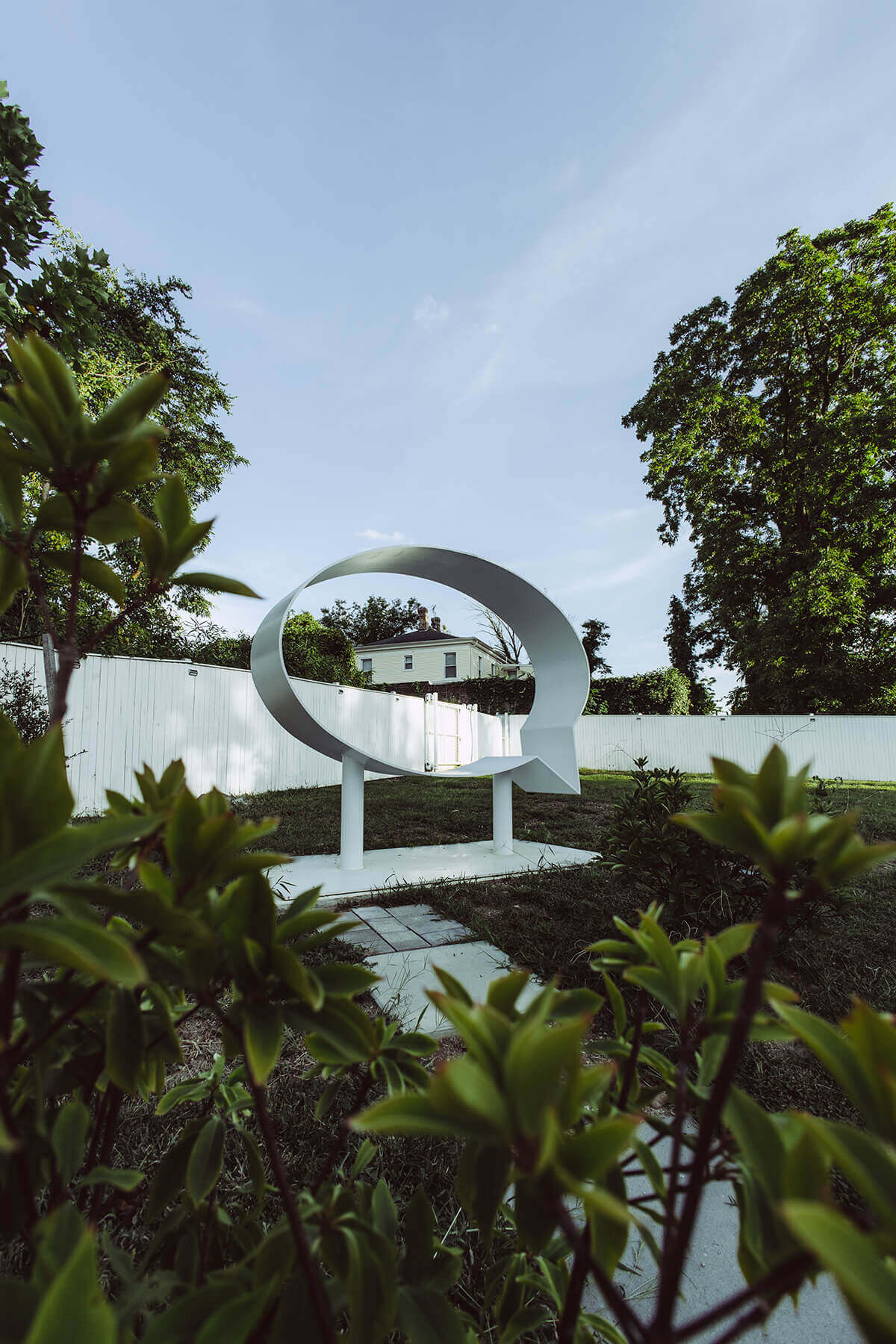
Clockwise from bottom left: Scenes from the Last Resort, including a view into the kitchen nook, the sculpture garden, and one of many corners of greenspace.

n the corner of Greenmount Avenue, Adams stops to admire two dining-room chairs that have been set opposite of one another inside the chain-link fence of the empty double lot that he has owned since 2020, like some makeshift installation. They were actually placed there by another local artist whom Derrick met on the street yesterday. He finds it a fitting visual for this once-forgotten parcel that, soon enough, will be home to his next vision.
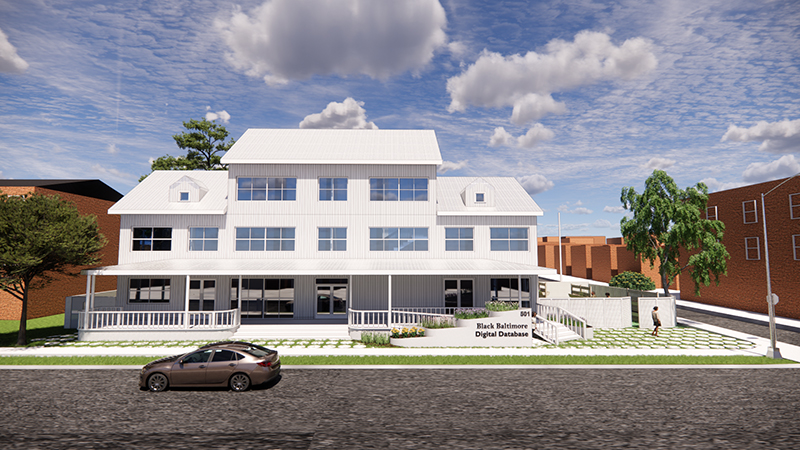
A rendering of the Black Baltimore Digital Database in Upper Waverly. —Courtesy of Derrick Adams Studio
The Black Baltimore Digital Database came to Adams not long after he first learned about Hoes Heights, another neighborhood just 10 minutes away, where he was picking up a piece of furniture for the retreat. Nestled between two historically white neighborhoods, the leafy Roland Park to the north and the hipsterfied Hampden to the south, it was founded as a Black settlement by a freed slave in antebellum Baltimore.
“I realized that I didn’t know the history of my own city,” says Adams. “And that knowledge can give people hope. Because when you’re more aware of the past, it helps you navigate the present, and carve out a new path for the future.”
Ground remains to be broken, but once the Database is built, it will be a state-of-the- art community center and private collection dedicated to cataloging the oft-overlooked accounts and accomplishments of local Black citizens. Adams envisions a Mac-store-meets-library, with a digital archive lab, art gallery, and screening room. A $1.25-million Mellon Foundation grant has helped kickstart that work, and a fundraising campaign is now underway for the building’s construction.
As with The Last Resort, Adams chose Waverly because of its central location. A cultural crossroads of Baltimore, the neighborhood is near branches of the Enoch Pratt, college campuses like Johns Hopkins and Morgan State, the Baltimore Museum of Art, and the 32nd Street Farmers Market. Surrounded by both Black and white communities, it’s a straight shot to either the county or downtown.
In the heart of Baltimore, establishing physical space is an intentional choice by Adams. He is making room for creatives of color as the city continues to grow and change. Perhaps with these landmarks, he hopes, they will not only come here, but stay.
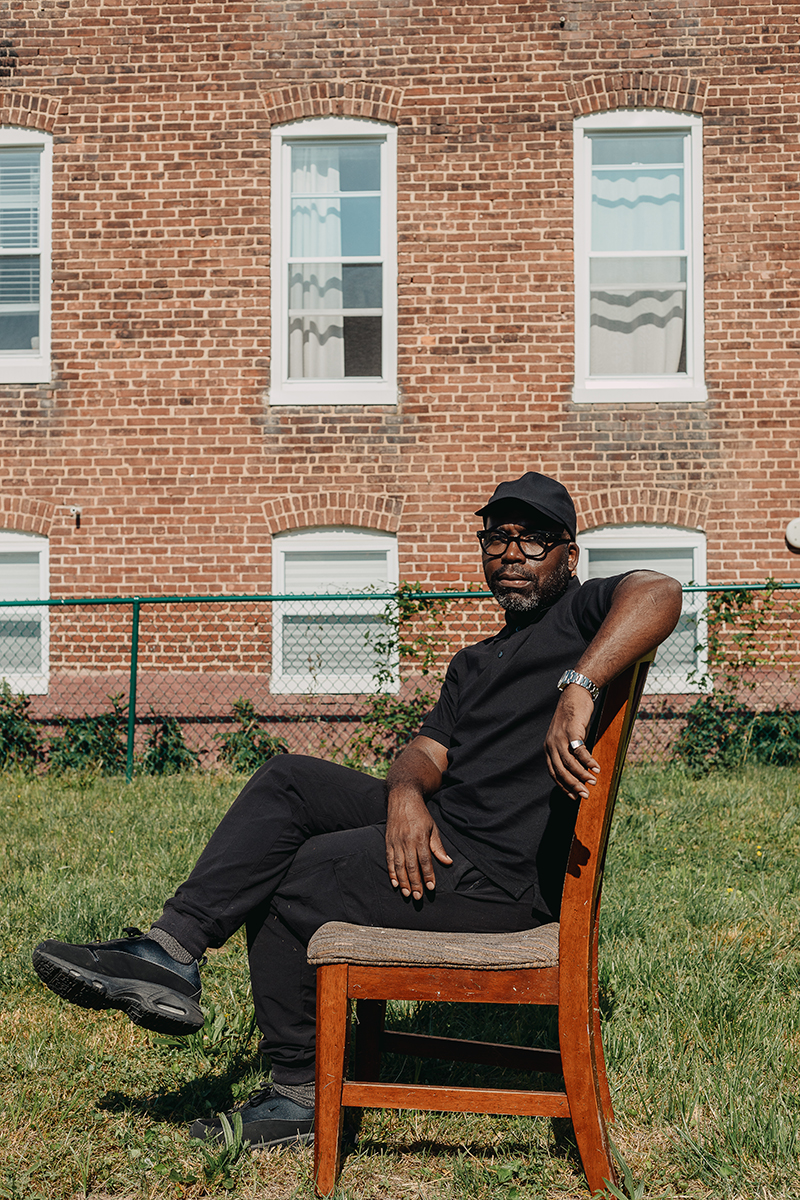
Adams poses in front of the Black Baltimore Digital Database.
“Derrick is providing something that is invaluable to this community,” says the BMA’s Brown. “I hope that artists in the generations to come will look at his example and be inspired to give back as well, and to create opportunities for collectivity that he is doing so rigorously and beautifully.”
Adds Miller, “He is a dreamer and a doer and an extraordinary artist. He has a plan, and he executes on it. But the secret sauce is his humbleness. Baltimore should watch out. There are going to be more things coming from Derrick Adams.”
Back at The Last Resort, Adams is sitting in the small breakfast nook at the south end of the kitchen. The afternoon light seeps into the room and slants across a framed photograph of a Black boy holding a cicada on a white picket fence, taken by the legendary Baltimore photographer, the late I. Henry Phillips Sr.
It’s his favorite room in the house, originally built in 1910, though all have been meticulously designed by the artist to make this place feel like a home. Like its exterior, the inside walls, ceilings, and floors have been painted white, and those boards creak when one wanders between the vibrant artworks—a surrealist portrait by local visual artist Devin N. Morris in one of the eight guest bedrooms, a whimsical scene of a Maryland crab feast by late screen-printer Tom Miller near the front door—filling every free inch like a mini museum.
Though his apartment and studio await him back in Brooklyn, Adams is here every other week, checking on the progress of the sculpture garden or meeting a local church to discuss potential collaboration. Sometimes his aunts and sister visit.
“Usually, they’ll come and stay all day, talking about family or growing up or the neighborhood,” says Adams. “I love listening to them talk about their life.”
That’s what he wants to share with the world. Through his art, and this space, and whatever comes next. All of those little familiar moments—the backyard barbecues, the stoops sits, the afternoons in the park or at the playground, full of wonder or boredom or contentment—that are a part of a Black life. “Those are the things that should be echoed louder,” says Adams. “And that’s what I’m trying to do here.”
